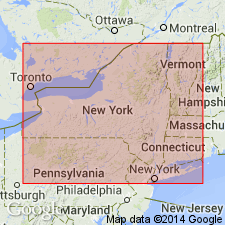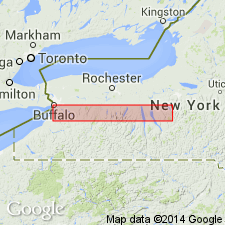
- Usage in publication:
-
- Mt. Vernon Bed
- Modifications:
-
- Overview
- Dominant lithology:
-
- Limestone
- AAPG geologic province:
-
- Appalachian basin
Summary:
Mt. Vernon Bed, at the base of the Darien Center Submember of the Wanakah Member of the Ludlowville Formation is a thin (10-15-cm-thick) argillaceous limestone typically containing small productid brachiopod TRUNCALOSIA TRUNCATA. In addition, the Mt. Vernon Bed is characterized by an abundance of pelagic styliolinids, orthoconic nautiloid cephalopods, gastropods, and unusually small brachiopods. Faunal assemblage reflects dysaerobic conditions at the sea floor. A peculiar undulatory concretionary horizon above Mt. Vernon Bed is here referred to as Stolle Road Bed and is well displayed along Buffalo Creek. Darien Center Submember overlies the Ledyard Shale Member of the Ludlowville. Age of the Wanakah Shale Member and all its subdivisions is Middle Devonian.
["Submember" not recognized as a formal stratigraphic rank term (CSN, 1933; ACSN, 1961, 1970; NACSN, 1983, 2005). Considered informal until formally published. The rank or lithologic term should not be capitalized.]
Source: GNU records (USGS DDS-6; Reston GNULEX).

- Usage in publication:
-
- Mt. Vernon beds
- Modifications:
-
- Named
- Dominant lithology:
-
- Limestone
- AAPG geologic province:
-
- Appalachian basin
Summary:
Limy beds and concretionary zones near the top of the Pond Brook interval of the newly named Elma Submember of the Ledyard Member of the Ludlowville Formation, referred to as the STROPHALOSIA beds by Grabau (1899) were renamed the Mt. Vernon beds by Kloc (1983: SUNY M.S. thesis). According to present report, historical aspect of these beds make formal recognition important, even though they are thin (10 to 25 cm), discontinuous, and present only in western NY. Age is Middle Devonian.
["Submember" not recognized as a formal stratigraphic rank term (CSN, 1933; ACSN, 1961, 1970; NACSN, 1983, 2005). Considered informal until formally published. The rank or lithologic term should not be capitalized.]
Source: GNU records (USGS DDS-6; Reston GNULEX).
For more information, please contact Nancy Stamm, Geologic Names Committee Secretary.
Asterisk (*) indicates published by U.S. Geological Survey authors.
"No current usage" (†) implies that a name has been abandoned or has fallen into disuse. Former usage and, if known, replacement name given in parentheses ( ).
Slash (/) indicates name conflicts with nomenclatural guidelines (CSN, 1933; ACSN, 1961, 1970; NACSN, 1983, 2005, 2021). May be explained within brackets ([ ]).

